Food & Dining: A sweet Journey Around the World
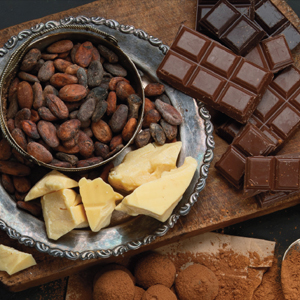
Over three decades back, they started out by selling wet grinders for making idli and dosa batter. Now, thanks to the ingenuity of this husband-and-wife duo, they are designers and manufacturers of innovative stone grinders that are revolutionizing the bean-to-bar chocolate industry.
Andal Balu, in her conversation with Khabar, talks about their journey into the world of gourmet chocolate, their impact on helping create artisanal chocolatiers in India and around the world, and her tips on how to taste and buy chocolate.
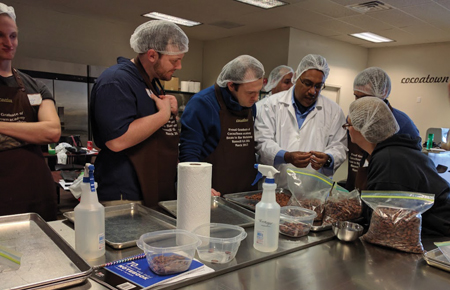
Bean to Bar workshop in Atlanta with Dr. Darin Sukha from University of West Indies, Trinidad, who is part of a select global team developing international standards for cocoa quality and sensory analysis.
Andal Balu and Dr. Balu M. Balasubramanian have played their part in revolutionizing the bean-to-bar chocolate-making industry, not only in the U.S. but around the world. The couple, originally from Tamil Nadu, started with their humble factory in Alpharetta, and are now exporting their machinery to chocolatiers in over 100 countries.
Growing up in India, I had never heard of the beanto- bar concept. In fact, as a kid, my love for chocolate was incessant, but my exposure was limited to Cadbury and Nestle brands that were manufactured locally at the time. It is only in the 2000s that craft chocolate makers popped up around the world and today, India is said to have only a couple of dozen professional craft chocolate companies— as opposed to over 300 in the U.S.
Last month, I sat down with Andal Basu at her office to learn about her journey into the exciting world of craft chocolates. As we sipped on hot cocoa and snacked on chocolate samples from all around the world, we shared our mutual passion for chocolate and travel.
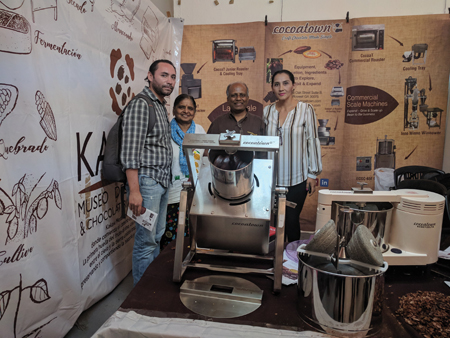
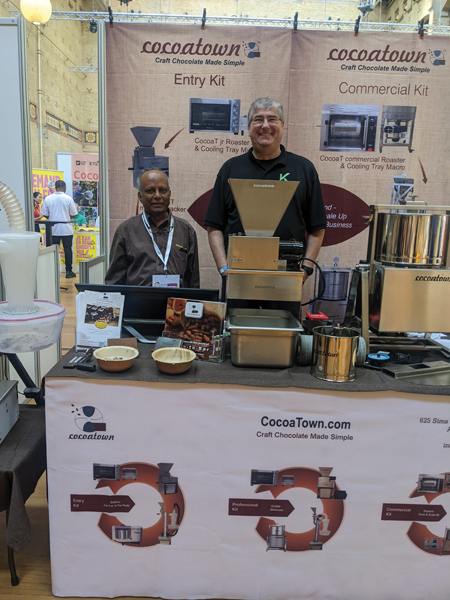
[Left] Andal Balu and Dr. Balu M. Balasubramanian with customers at CocoaTown booth in Tabasco Chocolate Festival in Villahermosa in Mexico
[Right] With their German distributor in CocoaTown booth at Chocoa Chocolate festival in Amsterdam, Netherlands.
Tell us a little bit about your company, CocoaTown.
CocoaTown designs and manufactures an innovative range of melangers or stone grinders that have revolutionized the bean-to-bar chocolate industry. Traditionally small-batch chocolate makers would need to invest in heavy, space-consuming, and expensive equipment. But with the patented CocoaTown machinery, anyone from home-based enthusiasts and farmers to professionals and chocolate shops can afford to make good quality chocolate without a lot of investment. We also customize the machines for each country and the client’s needs.
As a result, CocoaTown has been able to create new sources of employment and wealth in rural communities in India and all over the world. My husband, Dr. Balu, and I have traveled to Brazil, Dominican Republic, Nigeria, and many other countries to demonstrate how our machines work. We provide workshops on how to start and manage a chocolate-making business and also offer ongoing training and support to anyone who wants to learn more. We also go to chocolate festivals in many countries such as France, Germany, the Philippines, and South Korea where we meet with the end users and share the best practices of the industry.

[Top] CocoaTown helped their customers from Colombia and Suriname to exhibit their chocolates in Chocoa Chocolate festival in Amsterdam, Netherlands.
[Bottom] With chocolate makers in Ghana in an event organized by Cocoapreneurship Institute of Ghana in Feb. 2020
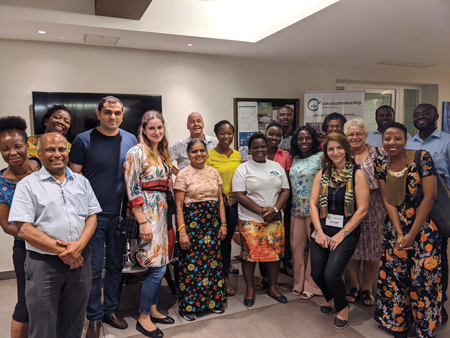
How did you come up with the idea of CacaoTown?
I studied Botany in India and worked as an agricultural scientist. When we moved to Atlanta in 1983 because of my husband’s job, I wanted to raise a family and work part-time in science. But there weren’t any opportunities that matched my criteria. So, I started my own business selling imported Indian spice blenders and wet grinders. It became quite successful. But a few years later, the recession hit, and I started exploring other sources of revenue.
I noticed that the clients who were buying my grinders were not all Indian. They were using the grinders for many different purposes such as making hummus, facial masks, nut butters, and chocolate. That’s when I got the idea of modifying the grinders to make cocoa grinding easier. Dr. Balu, who has a Ph.D. in Chemistry, jumped in and created the machines, some of which have patents for them. Now we operate the business together and enjoy sharing something with the world that has never existed before.
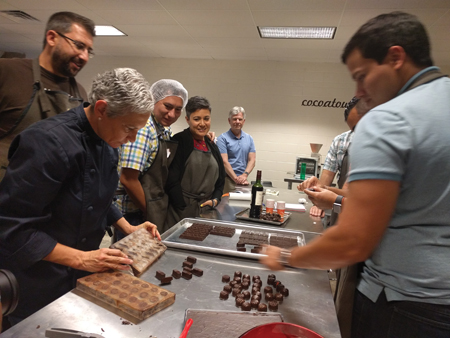
What does the cacao growing industry in India look like today?
Cacao fruit was brought to southern India by the British at the end of the 18th century. But it was the British chocolate company Cadbury that started giving out seedlings to farmers in the 1960s and ’70s. Cacao grows as an intercrop among areca nut (betel nut), rubber tree, coconut, and banana trees. Traditionally, cacao farming in India is inorganic and unsustainable.
[Left] A bean-to-bar workshop in Atlanta.
In 2014, we had a meeting with cacao farmers in Tamil Nadu and Kerala where I quoted from our Tamil literature about how we had the highest-yielding crops using organic methods. After colonial rule introduced modern fertilizers, the land became uncultivatable in a few years. There were very few organic farms at that time.
Fast forward to 2023, and there are now multiple organic farms as well as initiatives supported by the Government of India. In 2022, the state of Andhra Pradesh produced the highest amount of cacao, followed by Kerala, Tamil Nadu, and Karnataka.
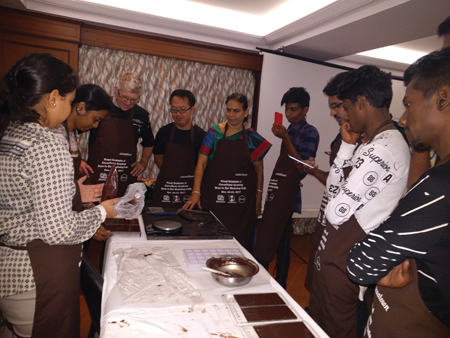
There are also many bean-to-bar chocolate makers in India that are supporting organic cacao farmers. These two segments feed each other to create a sustainable chocolate business.
[Right] A bean-to-bar workshop in Coimbatore India with Chef Stephen Durfee from Culinary Institute of America.
Tell us about your favorite Indian bean-to-bar chocolate brands.
CocoaTown is the first company in the world that introduced the bean-to-bar concept to India and conducted workshops in Coimbatore, Tamil Nadu. The first CocoaTown customer in India, Arun Viswanathan, won three international awards within the first six months of starting his company, Chitram Chocolates. Arun is very creative in coming up with new flavors using Indian ingredients such as mango lassi and moringa. His Infusions Café in Coimbatore has an entire menu based on cacao and chocolate. You can have chocolate idlis, idli chili powder with cacao nibs, and vegetable biryani with chocolate mole (Mexican mole) sauce!
California-based Srinivas Eerpina started Godavari Chocolates with his family members in Andhra Pradesh. They pay more attention to the fermentation of cacao beans on their farm. The chocolates are made in India and sold in the U.S. Chef Prateek at Ether Chocolate creates bean-to bar-chocolates and nut butters. We also like chocolates from Mason & Co. and Earthloaf.
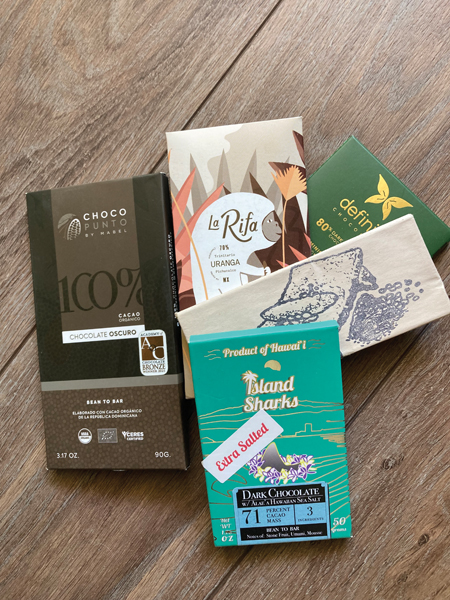
How can we tell what’s good chocolate?
Chocolate tasting is similar to wine tasting. Eating chocolate should involve all five senses. First, look at the shine and color of the chocolate. Break it and hear the snap. See how cleanly it breaks—as though you have cut it with a knife. Then, smell it. Take a small piece, put it in your mouth, break it with your front teeth a couple of times, and then let it melt in your mouth. Make sure your upper palate is covered with chocolate. You can also suck in air so that the flavor reaches your throat. Try to identify the flavors. These are a few things you can do to tell which chocolate is preferred by your palate.
[Left] Some of the chocolate brands of customers of CocoaTown.
How can we as consumers do better about buying and eating chocolate?
Health-conscious individuals are beginning to appreciate the health benefits of the two-ingredient chocolate (at least 65% of cacao and 35% or less sugar), and are willing to pay more for good quality ingredients versus the sugar-filled name brands. Over the decades, we have educated our audiences about the differences between beanto- bar chocolate, candy chocolate, and commercial dark chocolate. You need to pay attention to the ingredients. If you cannot pronounce an ingredient, that chocolate is not good for you.
Our advice is to buy from small chocolate companies. Most of the bean-to-bar, small-batch, craft, artisan, and micro-batch chocolate makers buy ingredients directly from the farmers or they source organic beans that are traceable to the origin of the beans. This ensures you are getting good quality produce that is also benefiting the grower. Buying craft chocolate is healthy for you, the small business-es, and also the cacao farmers.
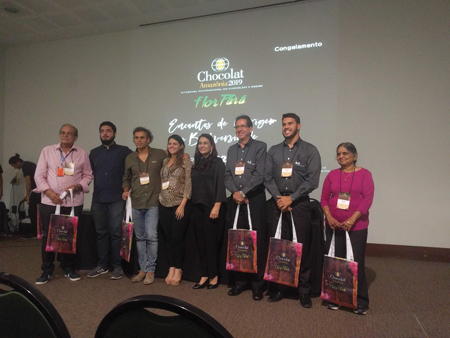
Andal Balu was a panelist for a seminar in Para Chocolate Festival in Belem, Brazil.
What has been the most interesting part of your chocolate journey?
I love to travel, so I have enjoyed traveling to different places and learning about different cultures. Going to chocolate festivals and conferences, and meeting farmers and chocolate makers has been very interesting. We have made a lot of friends from among our customers. One of them hosted us at their home in Tabasco, Mexico, where she took us to see a Ganesha statue in the local museum. When we went to a small community in rural Nigeria, one of the kings invited us to his village. It was a four-five hours drive from Lagos and, along the way, we saw people carrying water on their heads just like in India. When they served the meal, the king invited us to eat in the VIP tent where the other kings were seated. One of them asked us where we are from, and I said “CocoaTown in Atlanta.” He really thought we were the king and queen of an actual town!
Sucheta Rawal is an award-winning food and travel writer who has traveled to over 100 countries across seven continents, experiencing the world through her palate. She has been named one of the most influential cultural bloggers in the world for her blog Go Eat Give. Find her on social @SuchetaRawal.
Enjoyed reading Khabar magazine? Subscribe to Khabar and get a full digital copy of this Indian-American community magazine.
blog comments powered by Disqus










